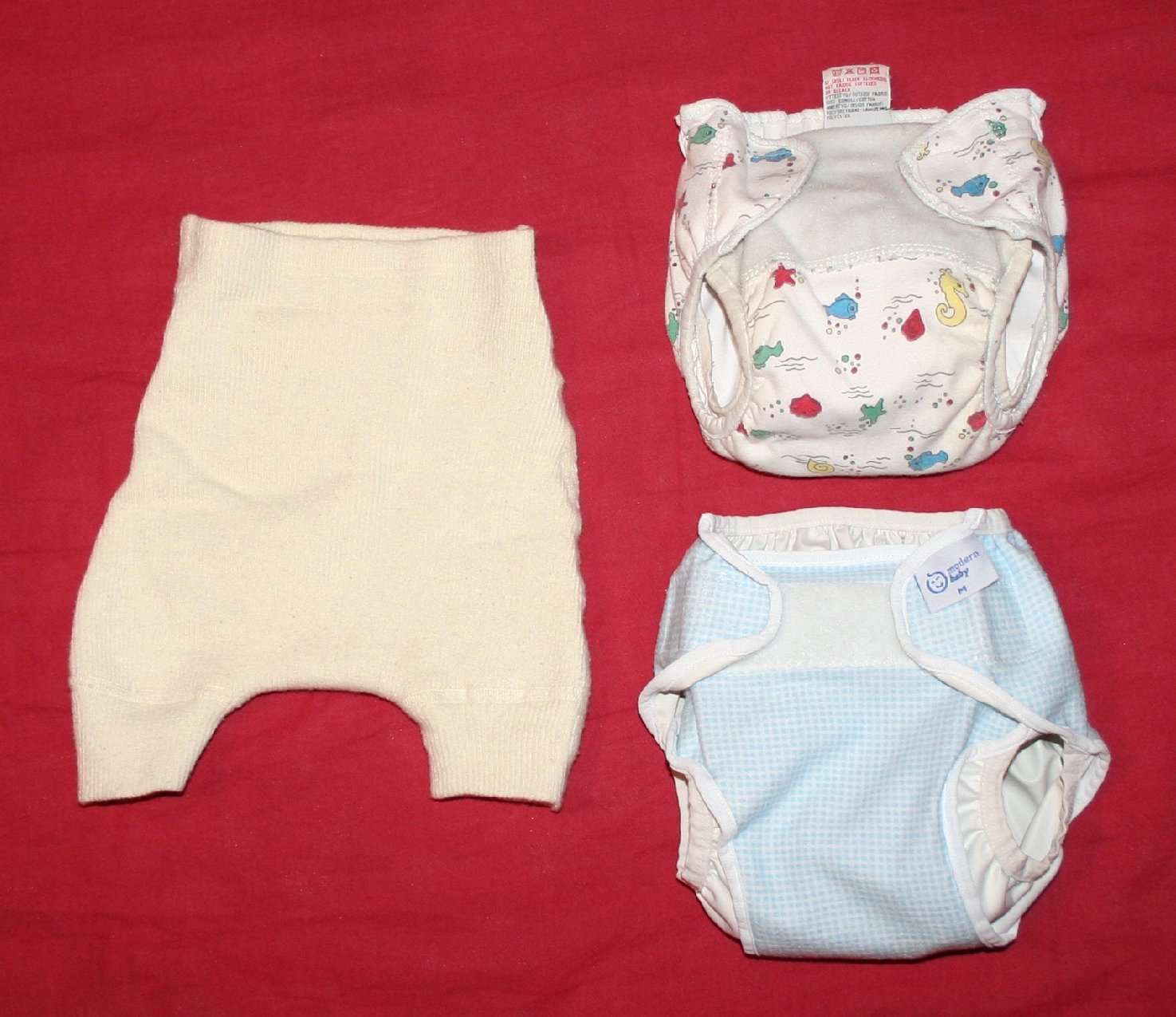|
Rubber Pants
{{Unreferenced, date=October 2018 Rubber pants or ''rubber panties'' were the predecessor to plastic pants and served the purpose of a diaper cover, replacing the woolen garment. However, "rubber pants" is still a generic term for any pull-on or snap-on incontinence protective garment. Lacking a fly front, the traditional variant is a true panty. As an infants' garment they had fallen out of favor in the 1950s, but were still the primary adult incontinence protective garment and in that role were called "rubber bloomers". Rubber pants for infants' wear over cloth diapers fell into two categories. Some were made of natural rubber and had rubber gathers at the waist and legs. The rubber pant itself was sized generously so the stretchy characteristic of rubber was not utilized and some air circulation took place within the oversized pants. Some were made of latex rubber that utilized the stretchy characteristic and fit very snugly over the diaper, leaving no air space. Perhaps the ... [...More Info...] [...Related Items...] OR: [Wikipedia] [Google] [Baidu] |
Plastic Pants
Plastic pants (also known as ''Waterproof Pants, Plastic Panties, Diaper Dover's, Nappy Covers, Dry Joggers, Nappy Wraps, Wraps, or Pilchers'') are devices worn over a diaper with the purpose of containing liquid or solid waste that could leak through the fabric. They are waterproof with a plastic feel, rather than the soft napkin feel. Today, plastic pants are usually made out of polyvinyl chloride (PVC) or polyurethane (PU). The availability of inexpensive, and easily manufactured, man-made waterproof materials since the 1950s has significantly improved the quality of life of those with continence problems. History At the turn of the 20th century, oiled silk was used as a waterproofing medium in adult clothing. This ended when latex rubber became widely available in the 1920s, when the idea of wearing protective garments became popular. Ladies' panties were worn with a waterproof latex crotch insert or a waterproof panel in the back of an underskirt, to make coping with hea ... [...More Info...] [...Related Items...] OR: [Wikipedia] [Google] [Baidu] |
Diaper
A diaper /ˈdaɪpə(r)/ ( American and Canadian English) or a nappy ( Australian English, British English, and Hiberno-English) is a type of underwear that allows the wearer to urinate or defecate without using a toilet, by absorbing or containing waste products to prevent soiling of outer clothing or the external environment. When diapers become wet or soiled, they require changing, generally by a second person such as a parent or caregiver. Failure to change a diaper on a sufficiently regular basis can result in skin problems around the area covered by the diaper. Diapers are made of cloth or synthetic disposable materials. Cloth diapers are composed of layers of fabric such as cotton, hemp, bamboo, microfiber, or even plastic fibers such as PLA or PU, and can be washed and reused multiple times. Disposable diapers contain absorbent chemicals and are thrown away after use. Diapers are primarily worn by infants, toddlers who are not yet toilet trained, and by chi ... [...More Info...] [...Related Items...] OR: [Wikipedia] [Google] [Baidu] |
Playtex
Playtex is an American brand name for undergarments, baby products, gloves, feminine hygiene products, and sunscreen. The brand began in 1947 when International Latex Corporation (ILC) created a division named Playtex to produce and sell latex products. Playtex was the first to advertise undergarments on national television in 1955, written by Howard Shavelson at Olgilvie and Mather, and the first to show a woman wearing only a bra from the waist-up in a commercial in 1977. They developed space suits for the Apollo program. Playtex-branded tampons were introduced in the 1960s and became the primary competition to incumbent Tampax. Playtex invented the plastic tampon applicator in 1973. It was one of the tampon manufacturers that were sued for aggressively advertising over-absorbent tampons that led to toxic shock syndrome. Playtex was acquired by JBS USA#Esmark, Esmark in 1975, and then by Beatrice Foods in 1985. A year later, it was acquired for $1.25 billion, and its cosmetics ... [...More Info...] [...Related Items...] OR: [Wikipedia] [Google] [Baidu] |
Fetish Fashion
Fetish fashion is any style or appearance in the form of a type of clothing or accessory, created to be extreme or provocative in a fetishistic manner. These styles are by definition not worn by the majority of people; if everyone wears an item, it cannot have fetishistic, special nature. They are usually made of materials such as leather, latex or synthetic rubber or plastic, nylon, PVC, spandex, fishnet, and stainless steel. Some fetish fashion items include: stiletto heel shoes and boots (most notably the ballet boot), hobble skirts, corsets, collars, full-body latex catsuits, stockings, miniskirt, crotchless underwear, jockstraps, diapers, garters, locks, rings, zippers, eyewear, handcuffs, and stylized costumes based on more traditional outfits, such as wedding dresses that are almost completely see-through lace, or lingerie for men. Fetish fashions should not be confused with costuming. They both involve clothing and intend to present an image, but a ... [...More Info...] [...Related Items...] OR: [Wikipedia] [Google] [Baidu] |
Rubberist
Rubber fetishism, or latex fetishism, is the fetishistic attraction to people wearing latex clothing or, in certain cases, to the garments themselves. PVC fetishism is closely related to rubber fetishism, with the former referring to shiny clothes made of the synthetic plastic polyvinyl chloride (PVC) and the latter referring to clothes made of rubber, which is generally thicker, less shiny, and more matte than latex. PVC is sometimes confused with the similarly shiny patent leather, which is also a fetish material. Latex or rubber fetishists sometimes refer to themselves as "rubberists". Gay male rubberists tend to call themselves "rubbermen". The terms "PVC", "vinyl" and "PU" tend to be used interchangeably by retailers for clothing made from shiny plastic-coated fabrics. These fabrics usually consist of a backing woven from polyester fibers with a surface coating of shiny plastic. The plastic layer itself is typically a blend of PVC and polyurethane (PU), with 100% PVC pr ... [...More Info...] [...Related Items...] OR: [Wikipedia] [Google] [Baidu] |
Polyurethane
Polyurethane (; often abbreviated PUR and PU) refers to a class of polymers composed of organic chemistry, organic units joined by carbamate (urethane) links. In contrast to other common polymers such as polyethylene and polystyrene, polyurethane is produced from a wide range of starting materials. This chemical variety produces polyurethanes with different chemical structures leading to many List of polyurethane applications, different applications. These include rigid and flexible foams, varnishes and coatings, adhesives, Potting (electronics), electrical potting compounds, and fibers such as spandex and Polyurethane laminate, PUL. Foams are the largest application accounting for 67% of all polyurethane produced in 2016. A polyurethane is typically produced by reacting an isocyanate with a polyol. Since a polyurethane contains two types of monomers, which polymerize one after the other, they are classed as Copolymer#Alternating copolymers, alternating copolymers. Both the isocy ... [...More Info...] [...Related Items...] OR: [Wikipedia] [Google] [Baidu] |
Plastic Pants
Plastic pants (also known as ''Waterproof Pants, Plastic Panties, Diaper Dover's, Nappy Covers, Dry Joggers, Nappy Wraps, Wraps, or Pilchers'') are devices worn over a diaper with the purpose of containing liquid or solid waste that could leak through the fabric. They are waterproof with a plastic feel, rather than the soft napkin feel. Today, plastic pants are usually made out of polyvinyl chloride (PVC) or polyurethane (PU). The availability of inexpensive, and easily manufactured, man-made waterproof materials since the 1950s has significantly improved the quality of life of those with continence problems. History At the turn of the 20th century, oiled silk was used as a waterproofing medium in adult clothing. This ended when latex rubber became widely available in the 1920s, when the idea of wearing protective garments became popular. Ladies' panties were worn with a waterproof latex crotch insert or a waterproof panel in the back of an underskirt, to make coping with hea ... [...More Info...] [...Related Items...] OR: [Wikipedia] [Google] [Baidu] |
Cloth Diaper
A cloth diaper (American English) or a cloth nappy or real nappy or a reusable nappy (Australian English and British English) is a reusable diaper made from natural fibers, man-made materials, or a combination of both. They are often made from industrial cotton which may be bleached white or left the fiber’s natural color. Other natural fiber cloth materials include wool, bamboo, and unbleached hemp. Man-made materials such as an internal absorbent layer of microfiber toweling or an external waterproof layer of polyurethane laminate (PUL) may be used. Polyester fabrics microfleece or suedecloth are often used inside cloth diapers as a "stay-dry" wicking liner because of the non-absorbent properties of those synthetic fibers. Modern cloth diapers come in a host of shapes, including preformed cloth diapers, all-in-one diapers with waterproof exteriors, fitted diaper with covers and pocket or "stuffable" diapers, which consist of a water-resistant outer shell sewn wit ... [...More Info...] [...Related Items...] OR: [Wikipedia] [Google] [Baidu] |


